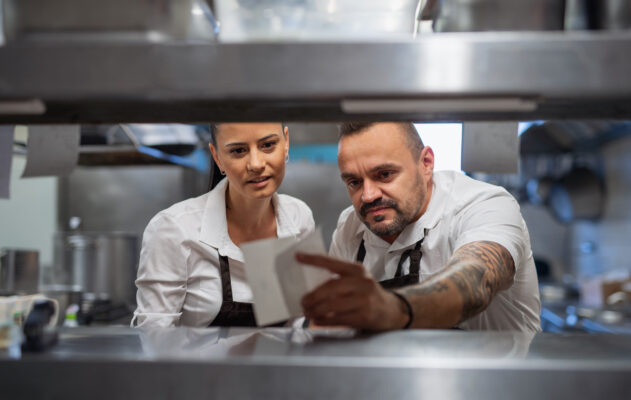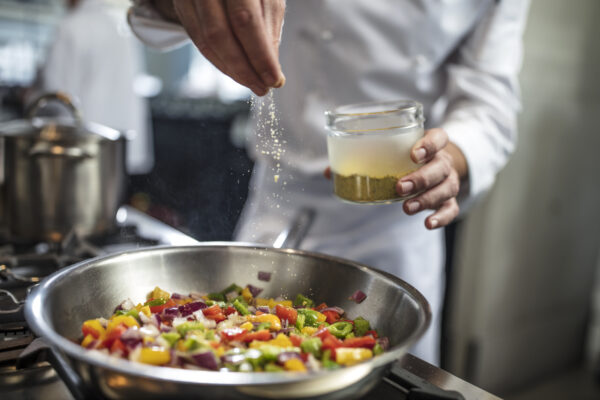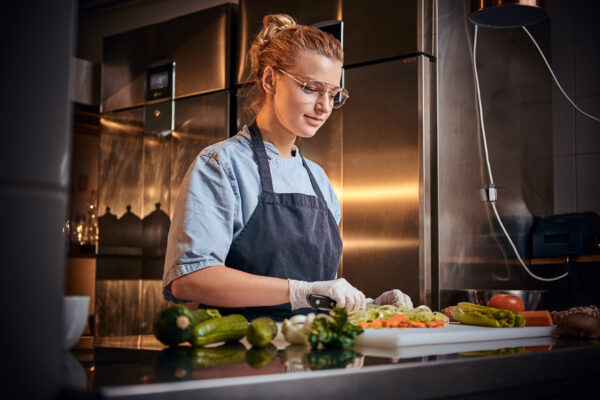Chef de Partie Job Role
Chef de partie is a confusing title for many. A kitchen hierarchy is based on a traditional French structure, hence why many countries borrow French titles for the different chef positions.
This interesting name for a chef is a common term that comes up again and again, but many find themselves asking what chef de party means.
I worked as a chef de partie for several years, and it is perhaps one of the most demanding roles in the kitchen, even if it does not carry the kudos that other higher-ranked titles come with.
A Chef de Partie is the head of a section within a kitchen. A professional kitchen is divided into sections such as meat, fish, veg, etc, and it is the role of the Chef de Partie to ensure their section runs smoothly. They also have several other important responsibilities.

So that’s the basic answer, but as always, there is a little more to it than that! There are important little nuances that anyone looking to begin a chef career should be aware of.
With that in mind, we’ll take an in-depth look at the role of the chef de partie and what their responsibilities are within a kitchen.
What Does a Chef de Partie Do?
As mentioned above, a chef de party must take control of a section of the kitchen so that it can work alongside all the other sections to produce flawless dishes every time!
A Chef de Partie will control their section of the kitchen. They will often have more inexperienced chefs, known as commis chefs, working below them. As a team, they will produce the elements of the dish that their section is responsible for.
For example, it is far more efficient to have one team produce the veg for all the dishes than to have each team produce multiple elements.
As a basic illustration, so we understand why sections are so important in a kitchen at scale, we shall look at a very simple example below:
If our restaurant has just two items on the menu (it probably wouldn’t be very popular, but we can run with it!)
- Fillet steak with green beans and new potatoes
- Sirloin steak with mushrooms and chips.
Now, in theory, we could ask one section to produce all of dish number 1 and another section to produce all of dish number 2. This would be an even way to split the workload in principle.

However, the problem is, this would be chaos! The chefs would be tripping over each other to get to the grill, they would be getting in each other’s way in the veg store, and there are also the food hygiene cross-contaminating issues to consider!
A far more efficient way is to ask one section to cook the meat for both dishes and one section to cook the potatoes and veg for both dishes.
This is a very simple example but hopefully illustrates the point. Especially when we consider the menu will have multiple dishes, having clearly defined sections is the only way to do it efficiently.
It would not be uncommon to see three chefs per section.
In our example, if there were three chefs in a section, one of those would be a chef de partie, and the other two would be commis chefs.
The chef de partie will be guided by the sous chef and head chef working above them, in the same way, a manager in other career areas will guide their staff.
Chef de parties will then take this information and relay it to the commis chefs working below them.
The Responsibilities of a Chef de Partie
The role of a chef de partie is very hands-on, as they are ultimately responsible for all the elements being produced in their section. They will prep the dishes during the day and be on the stove cooking during service times.
It is their job to speak to the sous chef and the head chef to ensure they understand the elements of the dishes they are responsible for. Whilst a chef de partie has input in menu creation, they are expected to carry out the vision of the head chef.
Morning meetings among the chef de parties, sous chef and head chef will focus on which sections are going to be responsible for which elements that day.
Some may be obvious, but the fish fillets are going to come from the fish section! However, often, times there is some ambiguity; for example, the sautéed beans may come from that fish section as well that day rather than the veg section.
This approach prevents one section from becoming overwhelmed during service. When a menu is written, it is done so with the idea of sharing the workload among the sections, but in reality, this can be tricky.
A situation where one section is so busy it cannot cope while another section stands by twiddling its thumbs is of no use to anyone!
Once the chef de partie knows exactly what their section is responsible for and how the elements of each dish should be created, they will set about putting their team to work.
They will relay the information to the commis chefs in their section and assign tasks to each one based on their experience levels.
It is a chef de partie’s role to train the inexperienced commis chefs below them, as well as to ensure the overall section is ready for service on time.
This role carries a high amount of responsibility and is often the first step up that ladder from beginner chef. As such, several important qualities are needed before taking on the role.
What Qualities Does a Chef de Partie Need to Have?
We can see that the role of a chef de partie is very demanding. For chefs looking to make the step up from commis chef to this level they will need to demonstrate several important characteristics.
A Chef de Partie should be well organised, comfortable with issuing instructions, and a very reliable cook during service periods, as well as many other important points we shall look at.
Important Chef de Partie qualities are:
- Organised: There’s a lot going on in a kitchen on a normal day, and it’s even worse on a busy day! Chef de parties must be able to prioritise the workload and hopefully stay one step ahead on the prep work.
- Leadership skills: Leading a small section of chefs is vital. Chef de parties must be able to get respect from the commis chefs below them.
- A great chef: Perhaps the most important skill for a chef de partie is the ability to cook well on the stove during service time. They must be able to stay calm and produce high-quality dishes. Any chef who cannot perform this task will struggle to ever progress.
- Ambitious: Leading a kitchen section is often challenging and not a job for the faint-hearted. A healthy dose of ambition is vital to keep the chef de partie on course and enthusiastic about the rigours of the role.
- Confidence: Taking responsibility for a section can sometimes require us to take the blame for things that are out of our control. It’s important that we can take this ‘on the chin’ without letting it damage our confidence levels.
Although these are the main traits, there is no one-size-fits-all type of person who steps up to become a chef de partie. Section leaders can range from loud and brash personalities to quiet and unassuming.
A great advantage of kitchen life is that respect is earned through hard work and talent. If a chef has great cooking talent but is naturally quieter, this is not a problem. The other chefs will follow them as they have gained their respect for the cuisine they can produce.
We often see unconfident newcomers gain stature as they progress in their careers. Often, those who start off shy and unassuming soon find their feet and are issuing out orders without any problems!

How Long Does It Take To Become a Chef de Partie?
Timescales vary greatly depending on the type of cuisine being cooked. Generally, the higher the standard of cuisine, the longer a chef will stay at commis level; there is just so much more to learn that it takes longer!
However, as a general guide,
To become a Chef de Partie takes, on average, around two years. This is the time required for a commis chef to gain experience and culinary qualifications. However, the standard of cuisine being produced has a large effect on this timescale.
Working in a reasonable kitchen that cooks food from scratch, a commis chef can work their way around all the sections (gaining the required experience) to then be considered for the promotion to chef de partie.
A chef de partie will always be qualified, or if they have chosen not to complete a qualification, they will need to demonstrate considerable cooking experience.
This two-year timescale is a guide, as it is up to the head chef of a kitchen to decide when a commis is ready to run their section.
Job opportunity also plays a large part. If a commis chef is ready to step up, but there are no chef de partie vacancies in their kitchen, then unfortunately, they will have to bide their time.
Often, due to the transient nature of catering, we see the eager commis chef start to look for other kitchens where they can progress their career quicker.
We must also remember that a chef de partie in one kitchen is very different from another. A chef de partie in a pub restaurant will not be able to become a chef de partie in a Michelin star restaurant overnight. They will need to step back down to commis level in the higher standard restaurant before progressing again.
Many chefs also choose to stay at the commis level for a long time in order to gain as much experience as possible. Chefs who like to travel may choose to spend years moving between high-end kitchens and staying at a lower level. This has a catapult effect on their careers when they decide to move up the ranks.
Commis chef can be a difficult role for some, and they are eager to progress as quickly as possible. As well as the extra respect and status chef de partie level gives someone, the associated pay rise is also very welcome!
To Sum Up
We have covered the traditional role of the chef de partie, but like all things, this is not a fixed concept that has to be adhered to at all costs!
Head chefs are free to staff their kitchen how they see fit. We may see two chef de parties on the same section, or we may see a kitchen with just a head chef, a sous chef and a commis chef, with no chef de partie present.
In general, the larger kitchens tend to stick more rigidity to the traditional structure. A large restaurant, and hence a large kitchen, gets very busy so they tend to follow the traditional structure as this produces consistent results.
Chef de Partie is a great level for commis chefs to aim for and is really achievable with a little hard work and by listening to sound advice.
The best jobs are never advertised. If you’re looking for the best deals, give us a shout. Send us your resume, cover letter, and a brief message outlining what job would make you happy.
Do you want to modernise the look of your CV?
Don’t have a cover letter? Here are some of the best tips on how to come up with one and a cover letter.
We list the best jobs in Ireland. Your dream jobs.

